- Details
- Written by: Mahdi
- Category: Research Groups
- Hits: 26
Continuous monitoring of industrial equipment is one of the key needs of modern industries, as it helps detect early deviations and prevent costly breakdowns. Sound and vibration anomalies often appear as the first warning signs of mechanical or operational failures. However, many conventional monitoring systems are limited by low sampling rates, lack of real-time analysis, or the absence of remote monitoring, making them less effective in demanding industrial environments. Previous studies have explored different methods for anomaly detection. Some focused on sound signal analysis using statistical methods, while others employed vibration sensors to detect abnormal patterns. Although these approaches provided valuable insights, most relied on offline processing or low-power hardware with limited frequency analysis capabilities. In addition, the lack of integrated network connectivity often prevented real-time remote supervision, which is increasingly critical in today’s connected industries.
Our research addresses these challenges by introducing an integrated system that combines the ESP32 microcontroller, FFT-based frequency analysis, and TCP/IP network communication. The innovation lies in merging high sampling rates, real-time signal processing, and a dynamic remote monitoring interface. This design not only increases detection accuracy but also allows flexible integration with various industrial devices, ensuring broader applicability across different sectors.
Initial experiments show that the proposed system can detect anomalies quickly and with high accuracy under diverse operating conditions. These results highlight the potential of our solution to enhance equipment performance, reduce maintenance costs, and prevent unexpected production stops. By bridging the gap between traditional monitoring methods and modern industrial needs, this system provides a practical, cost-effective, and scalable tool for ensuring reliability and safety in industrial operations.
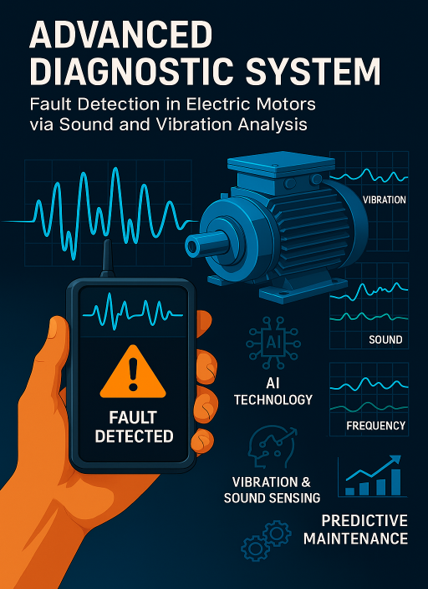
The proposed system is built around three main components: hardware, software, and network connectivity. On the hardware side, sound and vibration data are collected by sensors and processed in real time using the ESP32 microcontroller. Frequency analysis is performed directly on the device through the Fast Fourier Transform (FFT) algorithm, ensuring that anomalies can be detected quickly and efficiently without the need for heavy external hardware.
The processed results are then sent to a Python-based software interface, where the data is displayed and statistically analyzed to identify abnormal patterns. Finally, through the TCP/IP protocol, this information is transmitted to a web-based monitoring service, enabling remote supervision anytime and anywhere. By combining data acquisition, real-time processing, and online accessibility, the system provides a robust and scalable solution for modern industrial environments.
Hardware
The system uses an ESP32 microcontroller with sound and vibration sensors to capture data at high sampling rates. The KS-07S microphone records audio signals, while the ADXL335 accelerometer tracks vibrations, with interface circuits filtering out noise for clean analysis.Lightweight software on the ESP32 processes the signals using FFT and vibration intensity calculations, then sends the results to a Python-based interface. This setup makes it possible to detect and display sound and vibration anomalies in real time, with the added benefit of remote monitoring via network connection.
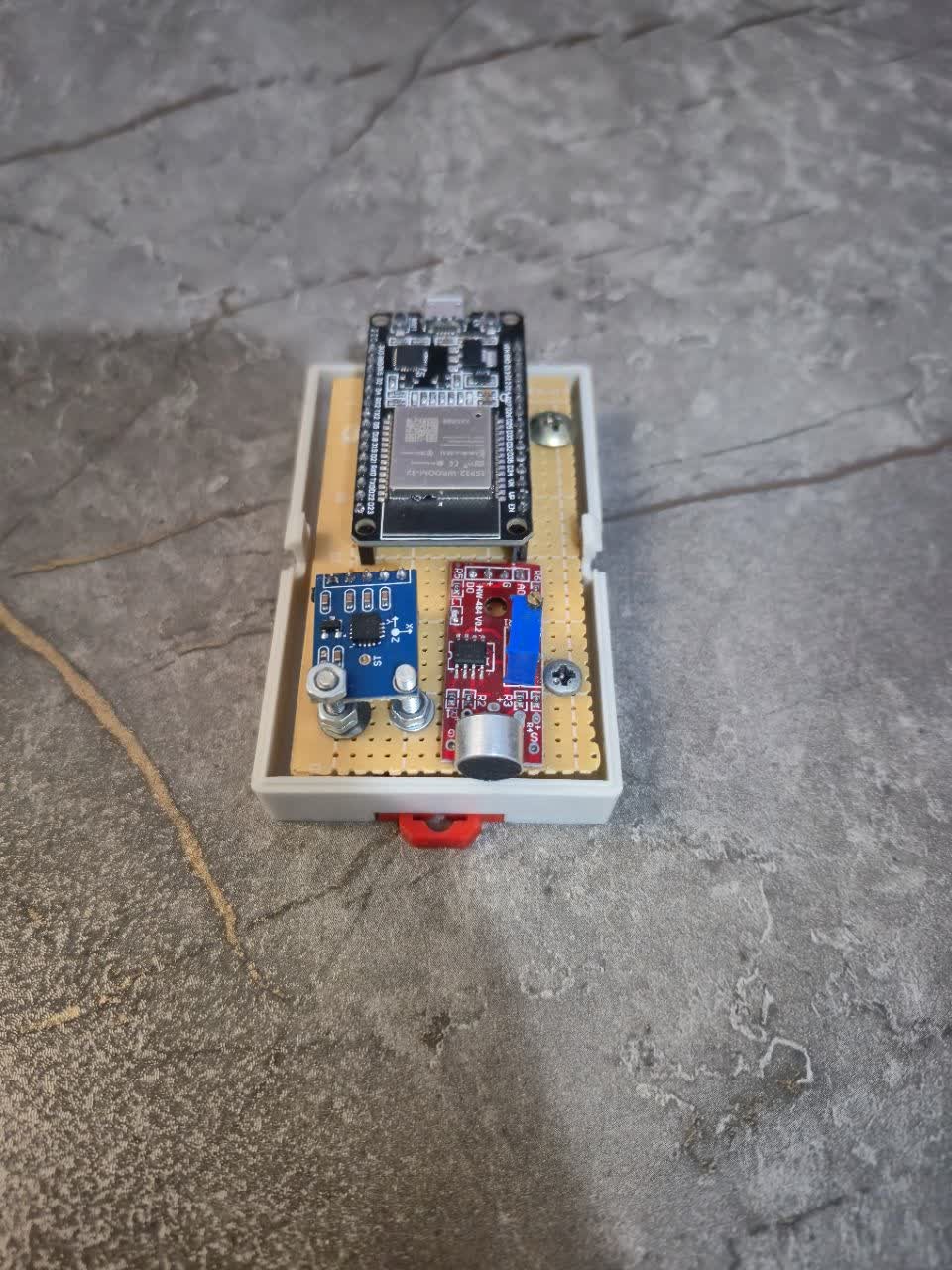
User Interface Software
The user interface was developed in Python using libraries such as ttkbootstrap, matplotlib, and numpy. It provides real-time charts for sound and vibration signals, threshold controls, and zoom features, while anomalies are detected using a z-score method for audio and a fixed threshold for vibration. For remote monitoring, data is transmitted via TCP/IP using the ESP32 with an ENC28J60 network module, and received in JSON format by a web service that displays live dashboards and anomaly reports. Network latency was measured at less than 100 ms, ensuring real-time performance. System evaluation in both real and simulated conditions confirmed its accuracy in detecting anomalies, fast response times, and stable operation even under noisy environments.
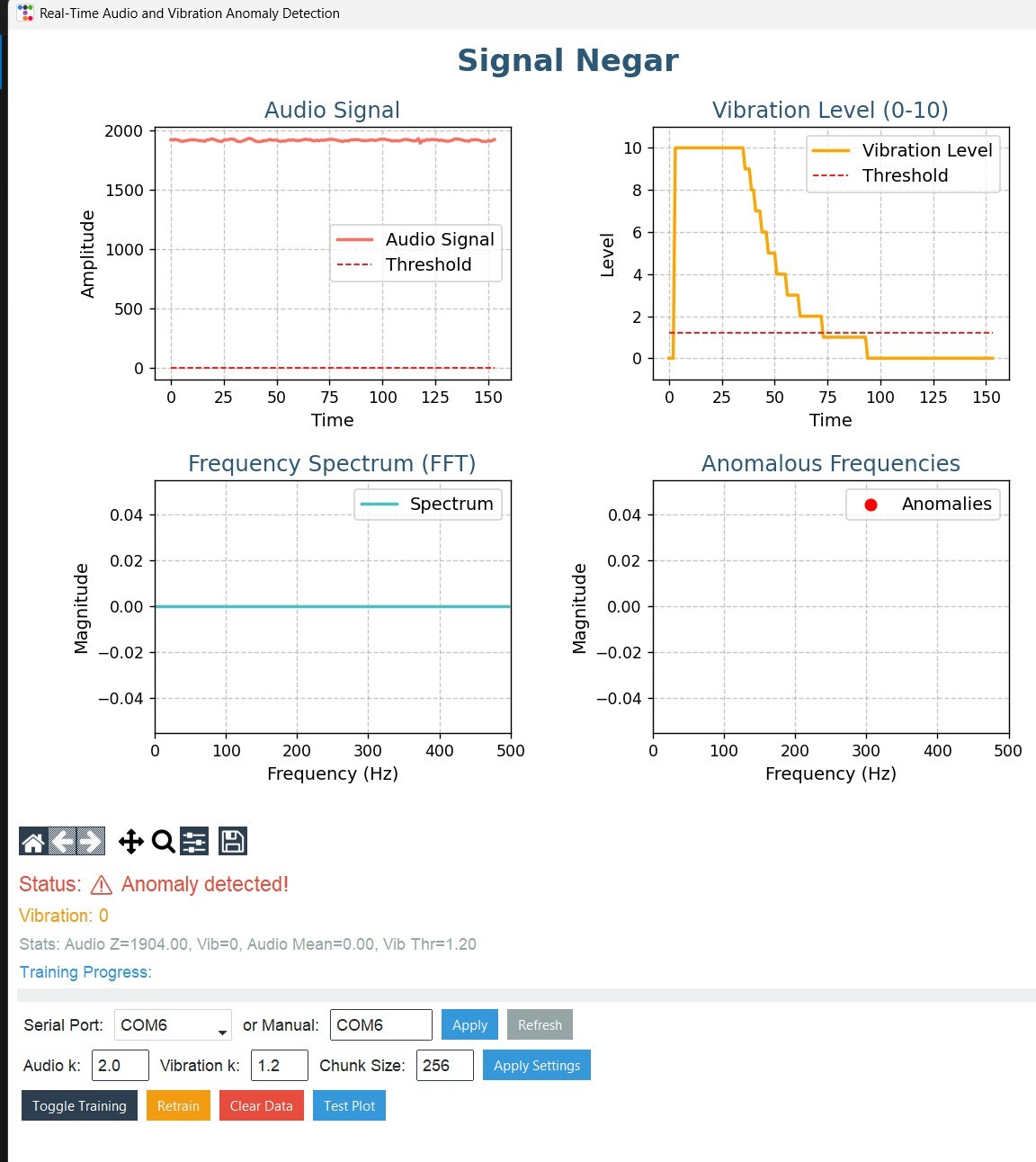
This study successfully developed an integrated system for real-time detection of sound and vibration anomalies in industrial equipment. The approach overcame common limitations of earlier solutions, such as offline processing, low sampling accuracy, and the lack of remote monitoring. Tests confirmed high accuracy in detecting anomalies, fast response times, and stable operation even under challenging and noisy conditions. These results underline the potential of the system to improve safety, reduce maintenance costs, and enhance efficiency in industrial environments.
At the same time, certain challenges remain, such as reduced accuracy in extremely noisy conditions and sensitivity limits for small-scale vibrations. Future research should aim to refine sensor accuracy, improve noise handling, and expand adaptability for diverse industrial applications. With these enhancements, the system can evolve into a reliable and scalable tool for smart factories, supporting safer, more efficient, and sustainable industrial operations.
Developed and researched by Alireza Maghsoudi – Aicer Lab
- Details
- Written by: Mahdi
- Category: Research Groups
- Hits: 59
Water, as the most vital resource for life, is increasingly threatened by chemical and environmental pollution. Traditional methods of water quality monitoring, while useful, are often costly, time-consuming, and limited in efficiency. To address these challenges, researchers have turned to innovative approaches such as biomonitoring—a technique that uses living organisms, especially fish, as sensitive indicators of environmental changes. In recent years, the integration of biomonitoring with modern technologies like image processing and machine vision has opened new horizons for real-time and accurate water quality assessment. This combination not only improves efficiency but also provides continuous, non-invasive, and highly sensitive monitoring, making it a promising solution for ensuring safe and sustainable water resources.
Global studies show big progress in using living organisms for water biomonitoring. Fish, daphnia, and other aquatic animals can act as early warning systems for pollution, showing changes in the environment before chemical tests can. But there are still many challenges, especially in bringing these systems to developing countries where equipment and expertise are limited.
Commercial platforms like FishToximeter and DaphniaToximeter work very well in laboratories and are highly accurate. However, they are expensive, need special conditions, and are hard to use outside controlled labs. They also depend on special hardware, private software, and expert operators, which makes them difficult to expand or use locally. To solve these issues, we need more affordable and flexible systems that can work in different environments and be easier to use in places with fewer resources.
The Aicer research team has developed an intelligent biomonitoring system named BIO AI. The main objective of this study is the design and implementation of an intelligent biomonitoring system based on the behavioral analysis of zebrafish, capable of detecting real-time changes in water quality and providing early warnings of potential pollutants. Using advanced machine vision algorithms, the system records and analyzes fish movements under both normal and contaminated conditions, enabling the identification of abnormal behavioral patterns caused by toxic substances. In addition to the visual monitoring module, the project also introduces an independent environmental control system built on the ESP32 microcontroller. This module continuously monitors and regulates aquarium conditions such as water temperature, level, flow rate, and aeration. It integrates a DS18B20 temperature sensor with a PID controller, a water level sensor for maintaining a fixed volume (8 liters), a YF-S201C flowmeter for real-time flow measurement, and a timer-controlled relay for aeration.
By combining behavioral image analysis with automated environmental control, the proposed system delivers a comprehensive and fully automated biomonitoring solution that can be applied in water treatment industries, aquaculture, environmental research, and water resource management.
Electronic Schematic
This diagram shows how the ESP32 microcontroller is connected to different sensors and modules. The DS18B20 sensor measures water temperature, while a water level sensor checks both high and low levels. A 4-relay module controls devices such as the heater, the air pump (bubble maker), and the water level pumps. With this setup, the ESP32 can read the conditions of the tank and automatically switch equipment on or off to keep the water environment stable.
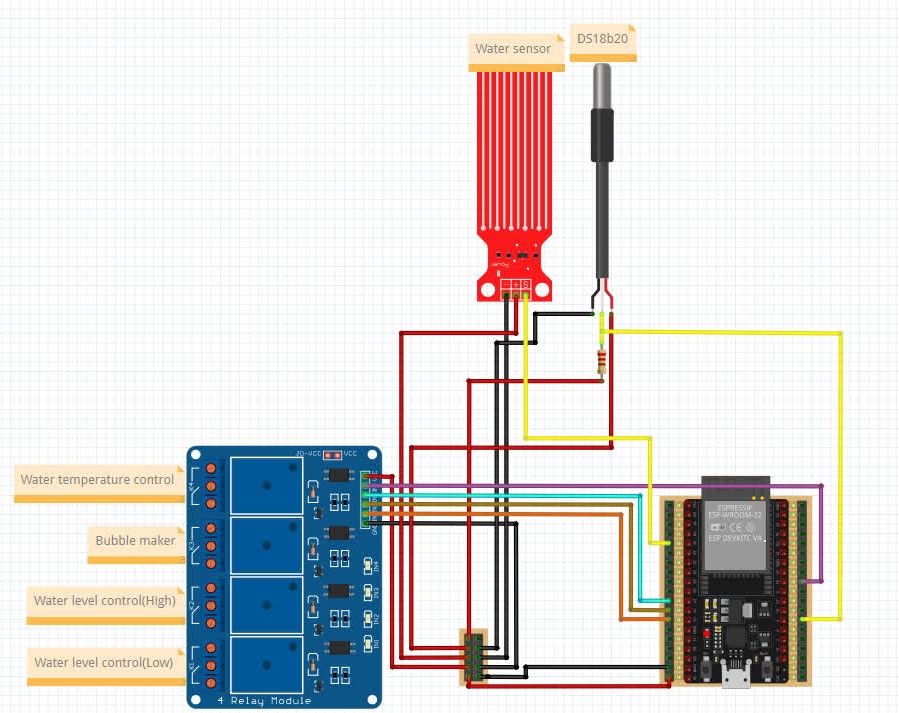
Control Board & Wiring
This part highlights the power supply, relay module, and wiring connections inside the device. The power supply provides stable voltage, the relay module acts as a bridge between the ESP32 and high-power devices, and the wiring links everything together. In short, this is the “hardware core” of the system that makes it possible to automatically manage temperature, water level, and aeration.
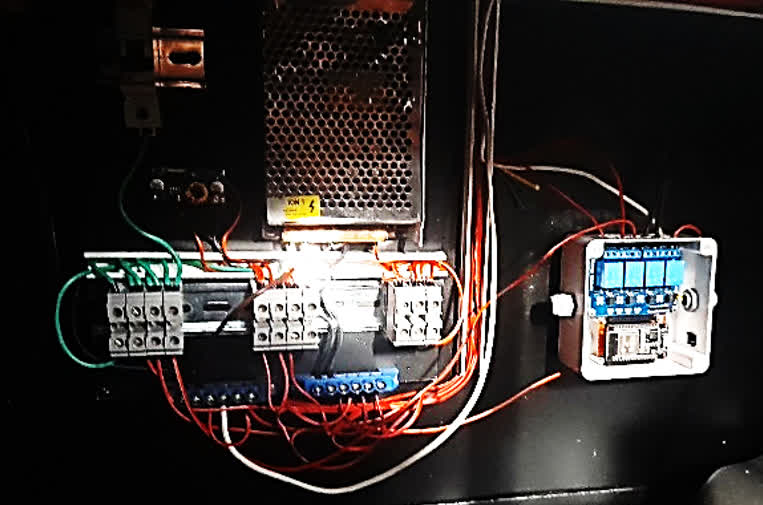
Final Device
The finished unit, branded BIOAI – AICER201, represents the final stage of development where all hardware and software components are fully integrated into a compact system. Designed for both industrial and research applications, this device combines automated water monitoring, intelligent control, and real-time image analysis in one unit. Its modular design ensures that sensors, actuators, and processing units are arranged neatly for reliability and ease of maintenance.
On the outside, the BIOAI – AICER201 has a protective enclosure that provides durability in different environments, while the internal structure organizes tanks, pumps, and control electronics into separate compartments. This design not only improves functionality but also enhances user safety and operational efficiency. The system is versatile enough to be deployed in laboratories, aquaculture farms, and industrial facilities, making it a practical solution for continuous biomonitoring.
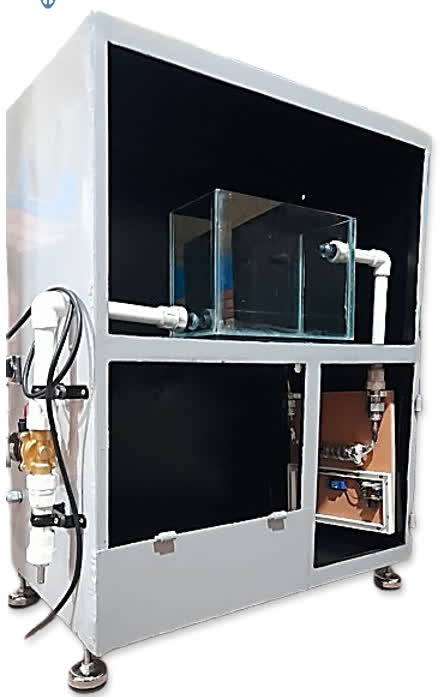
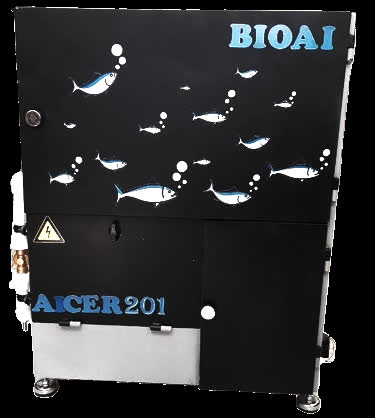
Conclusion
The development of BIOAI – AICER201 demonstrates how advanced technologies such as image processing, intelligent control, and real-time data collection can be combined to create a fully automated biomonitoring solution. By integrating hardware and software into a single compact unit, the system addresses key limitations of traditional monitoring methods, offering improved efficiency, lower operating costs, and greater adaptability.
In the bigger picture, this device highlights the importance of interdisciplinary research, where electronics, computer vision, and environmental science work together to protect vital water resources. As industries and communities face growing challenges of pollution and sustainability, solutions like BIOAI – AICER201 provide a clear pathway toward safer, cleaner, and smarter water management for the future.
Developed and researched by Arvin Zaheri – Aicer Lab
- Details
- Written by: Mahdi
- Category: Research Groups
- Hits: 45
Lithium-ion batteries have become the backbone of today’s clean energy revolution, powering everything from electric vehicles and consumer electronics to renewable energy storage. As their use grows worldwide, a new challenge has emerged: how to measure and manage the health of these batteries over time. This is where the concept of State of Health (SoH) becomes critical. SoH represents how much a battery has aged compared to its original state and reflects its ability to safely deliver energy. In simple terms, SoH tells us how “healthy” a battery really is.
Accurate measurement of SoH is essential because it directly impacts safety, performance, and cost. Without reliable SoH monitoring, batteries may be retired too early—wasting valuable resources—or too late, creating risks of failure and safety hazards. For electric vehicles and large-scale energy storage, real-time SoH monitoring also enables smarter battery management, ensuring better charging, discharging, and thermal regulation. This not only extends battery life but also supports safer and more sustainable use.
In electric vehicles, lithium-ion batteries are central to their performance, but even after reaching the end of their first life, they still hold significant capacity. These second-life batteries can be reused in less demanding applications such as stationary storage for solar and wind energy, backup systems for homes, or local microgrids. Reusing EV batteries in this way helps reduce environmental waste and provides cost-effective solutions for energy storage in different sectors.
Our research focuses on developing practical and accurate methods for SoH estimation, especially for these second-life batteries. Traditional laboratory approaches often struggle under real-world conditions, where noise and variability make predictions less reliable. By applying advanced machine learning techniques with electrochemical impedance spectroscopy (EIS) data, we aim to bridge this gap—offering solutions that are not only accurate but also robust, scalable, and ready for deployment in real-world energy systems.
In this study, we focused on estimating the State of Health (SoH) of lithium-ion batteries using advanced data-driven methods. To achieve this, we relied on Electrochemical Impedance Spectroscopy (EIS) tests, a powerful diagnostic technique widely used to study battery behavior.
What is EIS?
EIS works by applying a small alternating current (AC) signal to the battery over a wide range of frequencies and then measuring how the battery responds. This test provides a frequency-domain fingerprint of the battery, revealing valuable information about internal processes such as ion transport, charge transfer resistance, and overall degradation. Because every “aged” battery responds differently, EIS is a non-invasive way to detect hidden health conditions without dismantling the cell. we used seven key features extracted from Electrochemical Impedance Spectroscopy (EIS) tests as the input to our machine learning models. These features capture the essential characteristics of battery behavior across different frequencies and provide a reliable basis for accurate State of Health (SoH) prediction.
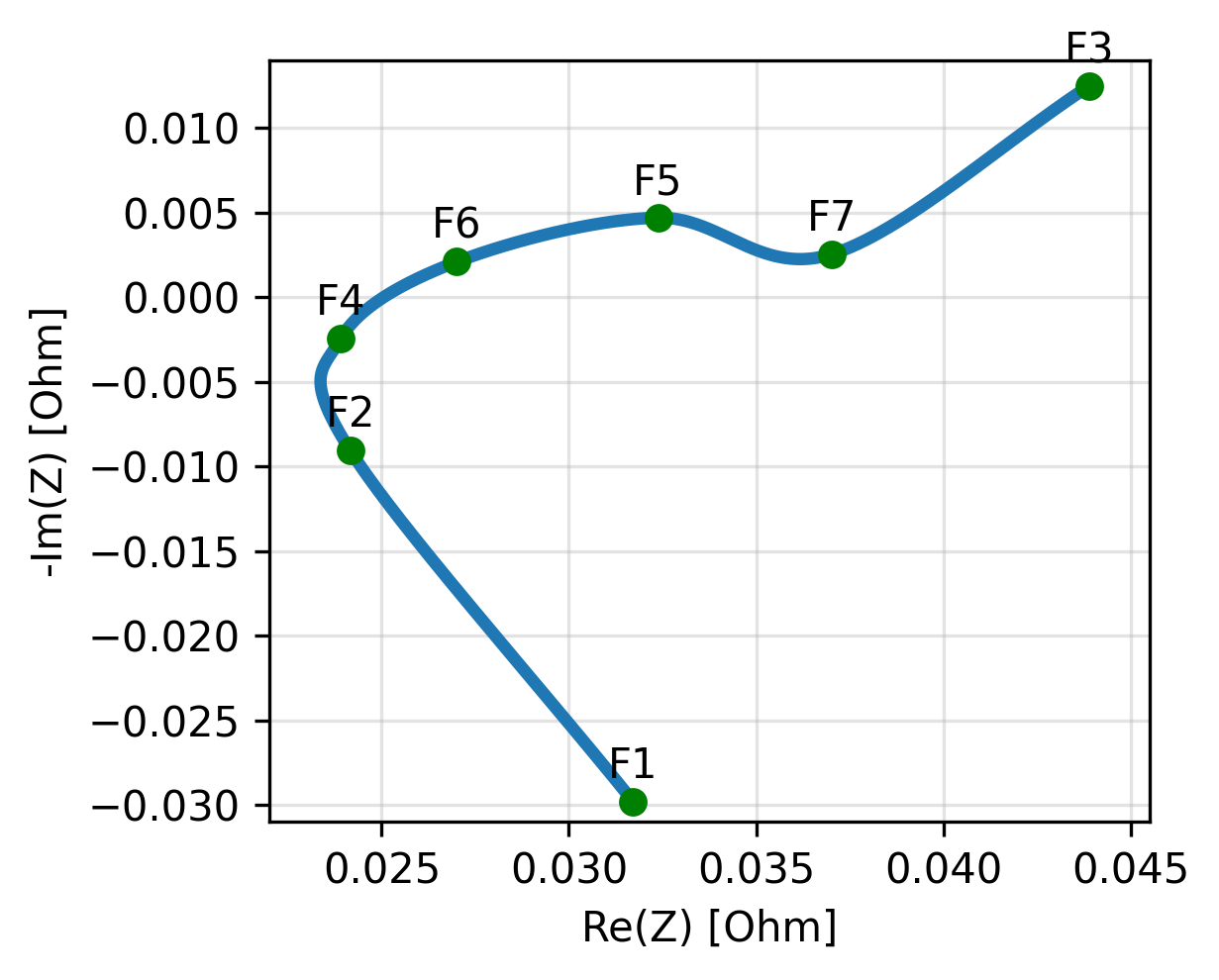
Applying Machine Learning
We trained and tested several machine learning algorithms using seven EIS-derived features to predict SoH. The Random Forest Regressor achieved the best results, with a prediction error as low as 0.08 RMSE, showing strong accuracy and robustness even under noisy, real-world-like conditions.
The two scatter plots below compare predicted and actual SoH values. Their close alignment highlights the reliability of our method and confirms that combining EIS features with advanced algorithms provides a practical framework for battery health monitoring.

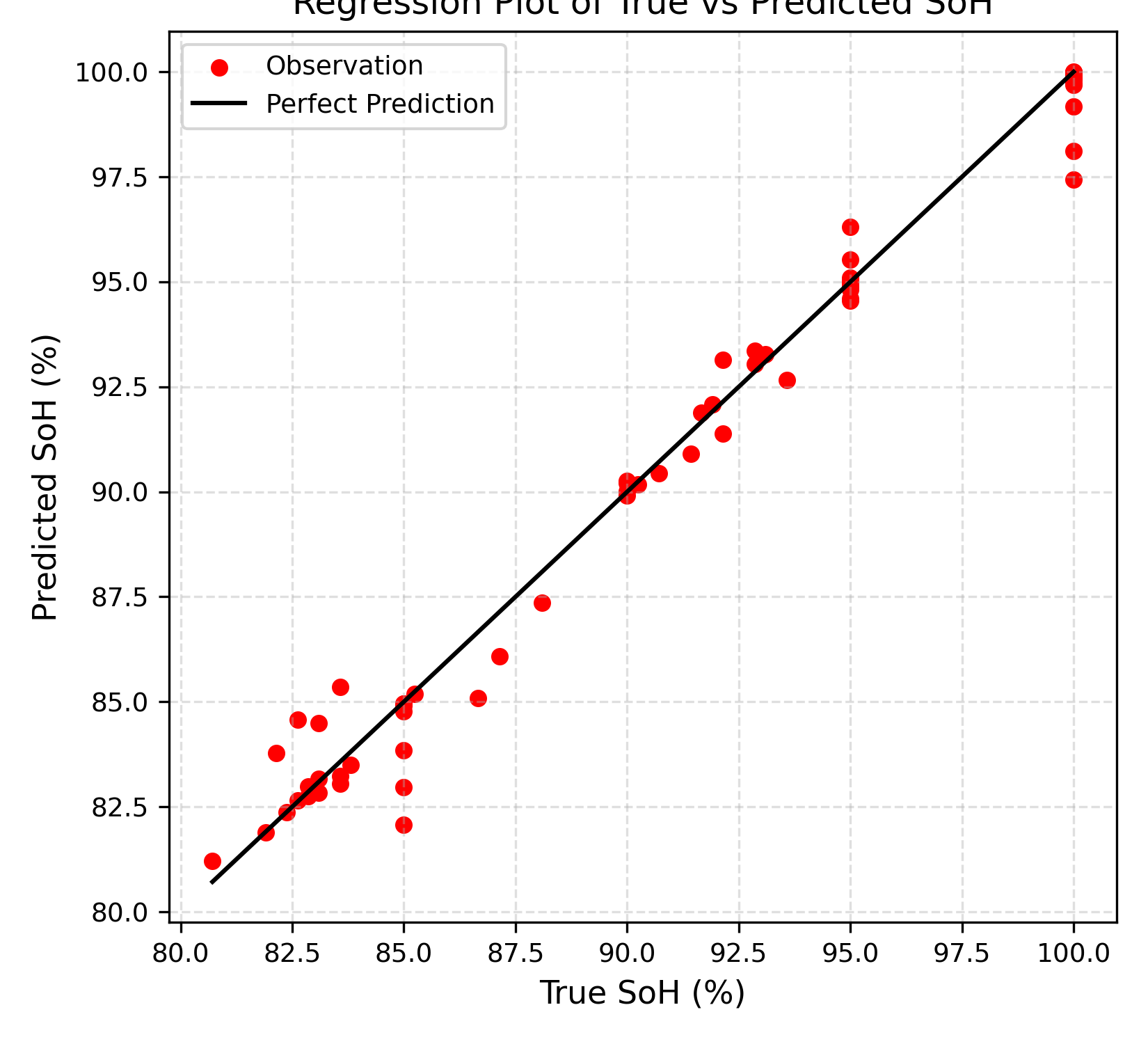
To ensure our model could work reliably in real-world conditions, we tested it against different types of artificial noise that mimic common errors in battery management systems (BMS). Three scenarios were considered: Gaussian noise, representing random electrical interference; Uniform noise, simulating evenly spread measurement errors; and Bias shift, modeling small calibration drifts in sensors. These tests allowed us to evaluate how well the Random Forest model performs when faced with imperfect and noisy data.
Unlike many studies that only add noise during testing, we introduced these patterns both in training and testing. This “noise-augmented” strategy, combined with a simple outlier-clipping step, helped the model learn how to deal with uncertainty while maintaining strong accuracy. As shown in the results, the prediction error (RMSE) stayed below 1.4% in all cases, proving that the approach is robust and practical. By training the model to handle noise, we make it much more dependable for real-world battery systems, where sensor measurements are rarely perfect.
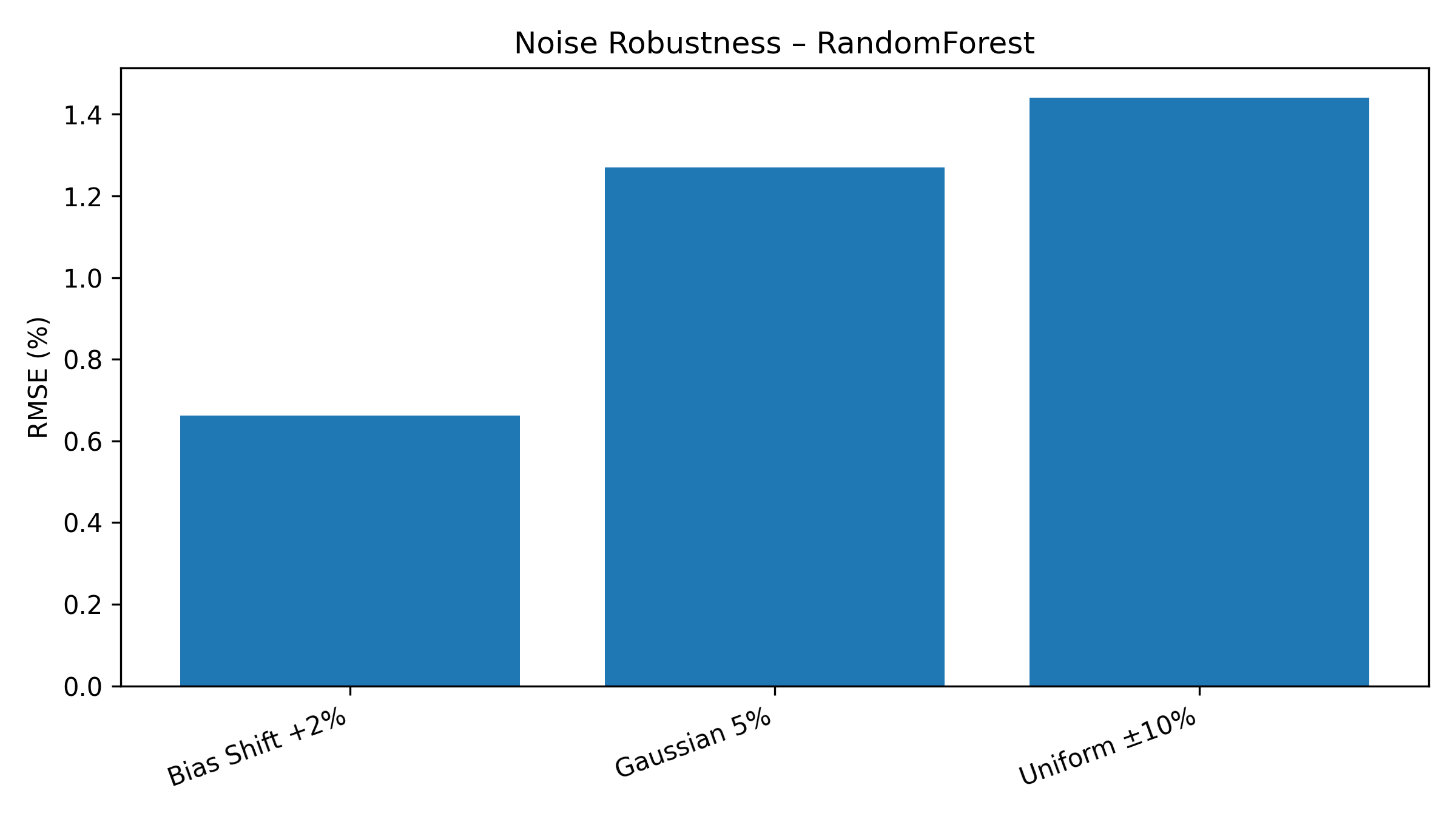
Our study demonstrates that combining Electrochemical Impedance Spectroscopy (EIS) with advanced machine learning models provides a powerful framework for reliable battery health estimation. By extracting seven key features from the EIS spectrum and applying them to algorithms such as Random Forest, we achieved highly accurate predictions of the State of Health (SoH). The results show that data-driven approaches can bridge the gap between laboratory analysis and real-world battery management, offering fast, non-invasive, and scalable diagnostics.
Beyond accuracy, the integration of noise-augmented training proved essential in making the model robust under realistic operating conditions. Even with different types of simulated sensor errors, the model consistently maintained low prediction errors, highlighting its readiness for deployment in practical applications. These findings underline the potential of combining physics-based insights with machine learning to extend the lifetime of lithium-ion batteries, enable safe second-life use, and ultimately contribute to building a cleaner and more sustainable energy future.
Nika Rahmani- Researcher at AICER Lab